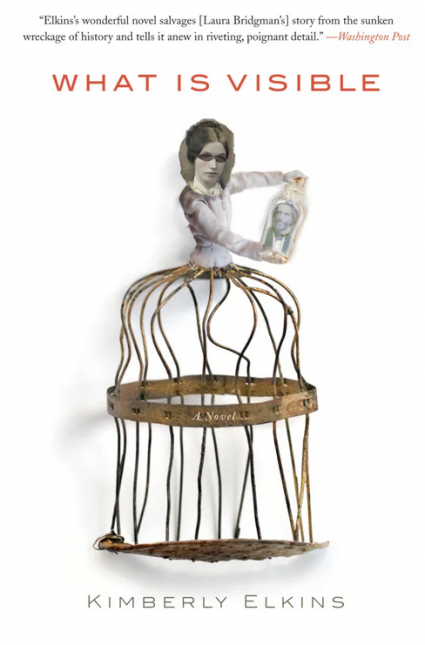What Is Visible: A Novel
- By Kimberly Elkins
- Twelve
- 320 pp.
- Reviewed by Carrie Callaghan
- June 25, 2014
Half a century before Helen Keller, Laura Bridgman earned fame and renown – though what she really wanted was love.

In 1842, a young Charles Dickens steamed over from Britain to travel the still-new American nation. He explored for four months, and in the account of his journey, American Notes for General Circulation, he introduced the world to Laura Bridgman, a 13-year-old girl at the Perkins Institution (today known as Perkins School for the Blind). Laura’s local fame and that of her teacher, Dr. Samuel Gridley Howe, reached new heights when Dickens described how the doctor had breached the “marble cell” of Laura’s mind, where she lacked sight, hearing, taste, or smell. Laura was the first deaf and blind child to learn English – over half a century before Helen Keller. With her novel, What Is Visible, Kimberly Elkins takes us inside that marble enclosure to relate Laura’s tremendous story, mostly from the girl’s cloistered perspective.
Laura was born in 1829 and contracted scarlet fever at the age of 2. The illness deprived the girl of four of the five senses, leaving her only with touch. But, as Elkins tells it, Laura is not trapped inside her mind. By the time we meet the adolescent girl, she can tell the size and mood of a crowd from vibrations in the floor; she can recognize a person from a hand she has held only once; and she is an avid reader. Laura is Howe’s prized student, and he displays her talents on regular exhibition days at Perkins, where she communicates by finger – spelling into his palm.
Laura, a proud, almost vain, girl, is pleased with her fame and the recognition she receives. But her preening is merely a symptom of a deep yearning for love. She receives little from her family, who live on a farm in New Hampshire, and relies instead upon Howe and her teachers to provide that love. But Howe, past 40, has turned his sights toward domestic life and the lovely Julia Ward, and Laura immediately senses a rival. When Howe takes Julia on a honeymoon to Europe, he allows Laura to tour their trans-Atlantic steamer prior to departure. A horrified Julia encounters Laura feeling her way through every inch of the stateroom. Julia watches as the girl studies everything with her fingers, from the cubbyholes of the secretary desk to the fixtures on the sink. Then Laura approaches the large bed, which is covered in silk and brocade. She vomits all over the rich linens.
Julia is convinced that the girl has ruined her marriage bed and, by extension, her marriage. Although Laura sends both Julia and her husband reams of letters during their honeymoon, which extends into a lying-in once Julia becomes pregnant, neither Julia nor Howe can bring themselves to return the needy child’s affection. And yet there is something compelling about Laura that neither they, nor her teachers, can resist.
This novel is not a love story but rather a story of love – or loves. Laura, Julia, Howe, and Laura’s teachers all navigate the same dark waters of life, searching for that elusive blend of affection, acceptance, and freedom. Laura’s physical challenges make her journey the most fascinating of the group, as she balances her confidence in her skills and beauty with a dawning recognition that the world may see her differently than she sees herself.
When she is 19, Laura relates with confidence the appearance of Edward Bond, a young man who has visited three times in a month. She knew it would not be long until she had a “proper suitor,” she tells us. But Laura’s understanding is painfully mistaken, and she must wait before she finds the love she seeks, if at all. I wish Elkins had not started the book with an advance view of a bitter Laura near the end of her life – the novel would have benefited from the tension that comes from wondering if the protagonist will find her happily-ever-after. But perhaps the tragedy of knowing the eventual fate of this bright, difficult girl is sufficient, poignant recompense.
Elkins has set herself an impressive challenge in her effort to portray Laura’s interior world. For those of us with all or most of our senses, Laura’s life seems isolated and dark. However, Elkins illustrates a passionate, determined young woman surrounded by equally driven companions and competitors, some who come to be like family to her.
The novel has its flaws, a few of which I hope are corrected in the next edition. On one page, Julia notes that her father’s death has limited her means, but two pages later, she describes how her father has just led her down the aisle in her wedding. Less egregious, but still disruptive, Julia subsequently bemoans the baby spit-up on her dress, although her child, by that point, is a year old. Toddlers, happily, do not spit up like infants do.
Those are quibbles, though. Elkins skillfully weaves the stories of love, longing, and jealousies between her characters, and creates a complex tapestry of emotion. Laura Bridgman may not have been the charming poster child that Helen Keller became, but Elkins makes a good case for her reinstatement into our popular memory. As Dickens wrote, Laura had a “keen enjoyment of existence,” and her story is a sober reminder of life’s joys, its challenges notwithstanding.
Carrie Callaghan’s short fiction has appeared in Silk Road, the MacGuffin, Weave Magazine, and elsewhere. She is a member of the editorial board of the Washington Independent Review of Books.

